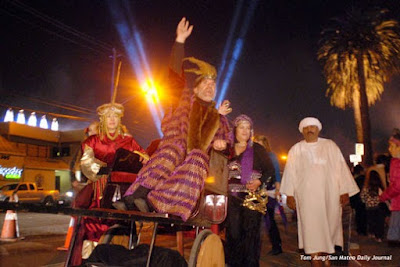For thirty years, Bethlehem A. D. has been a holiday event in Redwood City. The Rise Church has been presenting this recreation of Bethlehem as it might have appeared at the First Christmas, complete with Roman tax collectors, shops, temples, domestic animals, and of course, King Harod, seeking out male children aged two or less in an attempt to secure his own power.
It is sad that this will be the final act for Bethlehem because the lot where it is staged was owned by the Church, but had to be sold to raise money to restore the church after a recent fire. I only found this out when I checked with their Facebook page to verify the schedule, only to the the word "last" ominously attached to the dates. And while this is their thirtieth presentation, it was only my fifteenth, having photographed my first on in 2013.
 |
From 2013 Bethlehem 2013 A.D.
|
I was new in my role as an SMDJ Community Photographer, and relatively ignorant to the holiday events in San Mateo County. My editor suggested that if I never attended on, I might give the event a visit and bring back a photo. This I did, and actually scored a two-fer consisting of this photo, and one of two boys "talking" to a camel. It was a dumb luck photo, the sort one makes when the happen to be standing in the right spot at the right time, and your subject just happens to strike an animated pose as search lights across the street are spread out behind him. It became known as "the shot" among the Bethlehem people, and I gained some small notoriety as the photographer who made it.This year is a little different. The Heavenly Choir on the rooftop of the church was cut back to three angels, and many of the "actors" failed to show up on the first night. The Roman Legion was reduced to eight soldiers, down from at least a dozen, if memory serves me. Even King Harod's entourage was much smaller than years past. But the actors give it their collective all, in spite of the absences and that invisible pall that comes from knowing that this is the event's last year.
I made this shot during the dress rehearsal. Since the public wasn't present, I was able to set up a 10' light stand to achieve some high key lighting. I installed a Full CTO gel on the flash, and set the White Balance in the camera to 4500 Kelvin. This allowed me to warm the flash output and create a more natural balance for the existing tungsten lights. A subtle compromise white balance setting.
I overlooked the context provided in the background, and the number of recognizable (though unidentified) dancers in the image. I regret not submitting the image.
This camel photo was my second submission. The handler-camel affection is appealing0, and the costume gave me the necessary context. Unfortunately, this s hot had to be made early in the evening because I needed the sky to help separate my subjects from the background. If I waited an hour, I might have had some children in the shot, but the sky would have been completely black.
The image at the top of the post was the one submitted for publication. Because the event started on a Tuesday, I was confident it could be published in the Friday edition, giving the paper's readers a chance to attend that evening. As it turned out, the paper never published the image on Friday, or during the weekend. However, the grand finale of Bethlehem's thirty-year run was celebrated in several local papers, so I can believe that my photo would have been overkill for so local an event. The image could have failed to generate sufficient interest by the editorial staff, as it doesn't come anywhere near the visual interest of that image I summitted when the event was, to me, both new and novel.
I will certainly miss working this event every Christmas, and working with the dedicated staff who worked so hard to put it on. It gave me valuable experience in working flash outdoors and at night, and am thankful for the number of times the SMDJ published my work. For me, 2022 leaves with a whimper, not a bang. In spite of the disappointment, I am looking forward to my next assignment in 2023.



















%208x12x300.jpg)
%208x12x300.jpg)





























